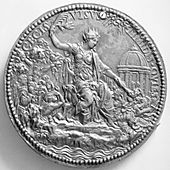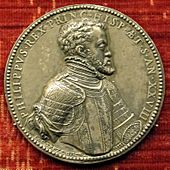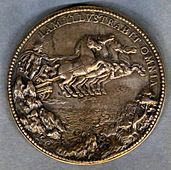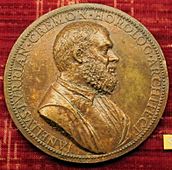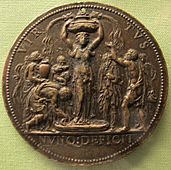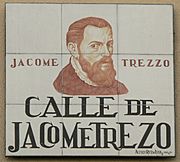Jacopo da Trezzo facts for kids
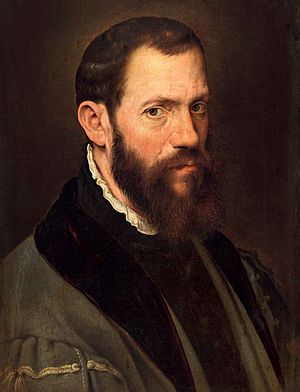
Jacopo da Trezzo (around 1515 or 1519 – 1589) was a talented Italian Renaissance sculptor and jeweller. He was especially known for making medals. He started his career in Milan, Italy. In 1554, he moved to work for the Spanish royal family, known as the Habsburgs.
He spent the rest of his life working for the Spanish court. This included a trip to England in 1554–55. This was during the marriage of Philip II of Spain and Mary I of England. Their marriage lasted from 1554 until Mary's death in 1558.
Jacopo was born Giacomo or Jacopo Nizzola (or Nizola). He was born between 1514 and 1519. His hometown was Trezzo sull'Adda, a village near Milan. In Spain, he became known as Jacometrezo. In Brussels in the 1550s, he signed documents as "Jacobo" or "Jacomo da Trezo".

Today, he is probably most famous for the eleven medals he created. He made these medals between 1548 and 1578 in Italy, England, and Spain.
Contents
Jacopo's Life Story
We are not entirely sure when Jacopo was born. One letter suggests he was 31 when he started working for Philip II. This would mean he was born around 1514–1515. His father, Gaspare, was called a "master," which meant he had a good job or social standing. By 1531, his family lived in Milan. Jacopo learned his skills from a carver of engraved gems and objects made from hard stones in Milan.
By the 1540s, Jacopo was a successful artist. He mainly worked in Milan. Important people like Cosimo I de' Medici, Grand Duke of Tuscany, hired him. From 1550 to 1552, Cosimo paid him for two large objects. These were a vase and a cup made from rock crystal (a type of quartz). Jacopo was even mentioned in the first edition of Vasari's famous book, Lives of the Artists (1550).
Milan was ruled by Spain at that time. Leone Leoni was a master of the mint there from 1542. He made many large portrait sculptures for the Habsburg royal family. Leoni had also made medals for the Habsburgs, including one of Charles V, Holy Roman Emperor, in 1536. However, by the 1550s, Leoni was more interested in life-size sculptures. It can sometimes be hard to tell the difference between Leoni's work and Jacopo's. Jacopo might have helped make coin dies, but there are no records to confirm this.
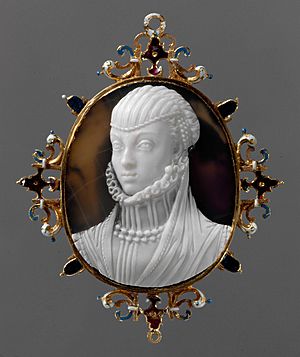
The Habsburgs probably learned about Jacopo da Trezzo through Leoni or Vasari. In 1554, they asked him to join their service. He seems to have first traveled to England. There, the future Philip II of Spain married Mary I of England on July 25, 1554. This was just two days after they first met.
Jacopo created medals to celebrate the marriage. He made two portrait faces and two symbolic designs for the back of the medals. Some versions of the medals had both Philip and Mary's heads, one on each side. Other, more traditional ones, had one person's head on the front (obverse) and a related design on the back (reverse). These medals were made from different metals, from lead to gold.
In late 1554, Jacopo sent a silver medal of Mary to Cardinal Granvelle in Brussels. Granvelle was like the Habsburgs' foreign minister. Philip's medal, however, is dated 1555. The medals with a head on each side were "an unusual combination." They might have been made by combining two earlier separate medals, perhaps from 1555. One of only two known gold examples of Mary's medal sold for a lot of money (£130,250) at Christie's in 2000.
After making Mary's marriage medal, Jacopo was named court sculptor (escultor) to Philip. This happened on New Year's Day 1555 in London. In 1555, he followed Philip to Brussels, the capital of the Spanish Netherlands. He stayed there until at least 1559. By 1562, he was in Madrid, where Philip was now King of Spain. Jacopo seems to have lived there for the rest of his life. He died in Madrid on September 23, 1589.
Jacopo's Works
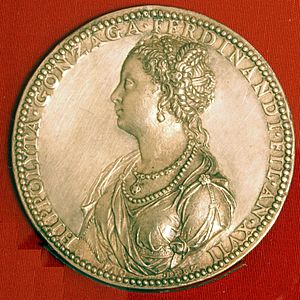
We don't know of any of his regular jewellery (like necklaces) that still exists today. He might have made some of the rich jewellery Mary I wore in her portrait by Anthonis Mor. This portrait is now in the Prado Museum. He was also known for engraved gems, and some of these have survived. While in Brussels, he made Philip's "great seal," which was used by 1557. He also engraved a diamond with the coat of arms of Charles V. Charles V also paid him in 1556 for a rock crystal drinking glass.
In Madrid, Jacopo made various hardstone carvings and cameos for the court. These were usually not signed, so it's sometimes hard to be sure which ones he made. The royal family used him to value and buy similar items, as well as old artworks. He also acted as a dealer. In 1584, he sold Philip the Annunciation painting by Robert Campin. This painting is now in the Prado and was bought for El Escorial. He also worked for other royal families. Records show he made works for the Medici family, the court at Parma, and the Austrian Habsburgs. The royal family and court often visited his workshop.
Jacopo, along with Pompeo Leoni and another artist, created the tomb monument for Joanna of Austria, Princess of Portugal (who died in 1573). Joanna was Philip II's sister. Her tomb is in the church of the Convent of Las Descalzas Reales in Madrid. She had founded this convent in her parents' palace in 1559. Jacopo also made the tabernacle for the main altar in the church of the monastery of El Escorial (1586). He followed a design by the architect Juan de Herrera. This tabernacle was made of gilt-bronze, rock crystal, and colorful hardstone.
He, or his workshop, might have carved the lapis lazuli cameos of the Twelve Caesars. These were later added around the edge of a fancy platter. This platter was made of engraved rock crystal, gold, gems, and enamels. It is now part of the "Treasury of the Dauphin" in the Prado Museum.
Jacopo's Medals
Some of his early medals made in Italy include those of Isabella di Capua and her daughter Ippolita (1535–1563). Isabella was the wife of Ferrante Gonzaga, who was then the Governor of the Duchy of Milan. These medals were made around 1552. Both are signed at the bottom of the portrait. For Isabella, it says "IAC.TREZZO," and for Ippolita, "IAC TREZ."
His medal of Mary of Hungary, who was Charles V's sister, dates from around 1549–51. The medal of her niece, Princess Joanna of Portugal (Philip II's sister), is from 1554. Gianello della Torre, an engineer and clock-maker from Cremona, also worked for the Spanish court. His medal seems to be from Jacopo's first years in Spain.
The marriage medals of Philip and Mary (mentioned earlier) were also made in oval versions. These only showed their heads. Much later, Philip was again shown in a similar round medal. Other medals he made were of Ascanio Padula (1577), who was an "Italian nobleman." He also made medals for the architect Juan de Herrera (1578), the Grand Inquisitor Diego de Espinosa (1568), and the Austrian ambassador Hans von Khevenhüller (1577). Khevenhüller was a neighbor in Madrid. He helped Jacopo get some jobs from other countries. The medallist Antonio Abbondio also helped him.
-
The back of Philip's medal: Apollo and the Chariot of the Sun.
-
Gianello della Torre, late 1550s.
Portraits of Jacopo
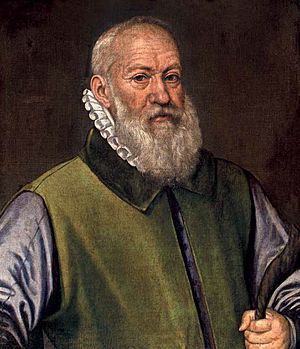
An interesting portrait by Anthonis Mor was likely painted in Brussels between 1555 and 1559. This painting was sold for a large sum (£1.93 million) at Sotheby's in London in 2019. Another portrait of Jacopo was owned by Philip II but is now lost. It showed "the famous sculptor next to the tabernacle he made for the main altar of the basilica of San Lorenzo at the Escorial." Another lost portrait was recorded as being by Bernardino Campi of Cremona. This one was probably painted before Jacopo left Italy. A third portrait, showing him as an older man, is believed to be by the Spanish court painter Alonso Sánchez Coello. This one might be from around 1580.
There is also a medal of Jacopo himself. It was made by Antonio Abbondio and is dated 1572. Abbondio was another Italian medallist who moved abroad. He mostly worked for the Austrian Habsburgs.
People in Training at the Workshop
Queen Catherine of Portugal, who was Charles V's sister, had many people working in her royal households. This was common at the Portuguese court. At this time, many of these people were from what is now Brazil, and some were from Portuguese Africa. They were generally treated well, and some were trained in different skills. However, they were also sometimes given as gifts. Others were later given their freedom.
In 1554, Queen Catherine sent three young people to her grandson in Madrid, Don Carlos. Don Carlos was the heir to the Spanish throne. By 1564, two of these young people, Diego de San Pedro and Juan Carlos, were being trained in Jacopo da Trezzo's workshop. Jacopo was later paid by Don Carlos' household for their food and clothes. Don Carlos' will, made in the same year, stated that they should be freed after his death. Don Carlos died unexpectedly early in 1568. Philip II later confirmed that they were given their freedom. Records of payments to Jacopo only appear in 1568. These payments were for expenses from 1564 and 1565. We do not know what happened to Diego and Juan Carlos after they were freed.
Jacopo's Legacy
The calle de Jacometrezo is a street in central Madrid named after him. It has a street sign with a picture based on the Mor portrait. There is also a plaque on the Casa Matesanz, Gran Via 27, Madrid. This plaque marks the spot where his house used to be.
-
Thought to be by Jacopo; a topaz carved with portraits of Philip II and his son Don Carlos, around 1566. It is in the Cabinet des médailles, Paris.
-
The tabernacle for the main altar of the church of El Escorial, made in 1586.
See also
 In Spanish: Jacopo da Trezzo para niños
In Spanish: Jacopo da Trezzo para niños


